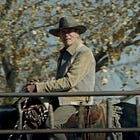Late Eastwood #10: Juror #2
A few words about the ideal Hollywood picture
We’ve come to it at last, the film this was all leading to: Juror #2. For years, I’ve been mulling over my aversion to keeping up with Clint Eastwood’s output. This wasn’t a political stance, but an aesthetic one. I had thought he reached a dead end somewhere in the late ‘00s. Friends assured me that no, in fact, Eastwood was still on fire, producing exciting and relevant work, and in my mind I’d already started to buy in. Despite not seeing them, I had good feelings toward Sully and The 15:17 to Paris and Richard Jewell and the rest. It was the trailer for Juror #2, with its brilliant premise and old-school charm that broke it all open. This was a movie I knew I wanted to see. I’d have liked to see it even if someone else had made it, but being an Eastwood film (and perhaps his last) only increased the appeal. My problem was, I did not want to be left out of the critical discourse among friends, who would surely be considering the film within Eastwood’s late oeuvre. It was time, finally, to put aside my remaining prejudices and dive in.
If you’ve followed along (thanks to my paid subscribers!), you know this has been a rewarding journey. Not every film has been great, but every one has been a fascinating object. It began with a re-assessment of Hereafter, a flawed but gorgeous film that would set the stage for the reflective mood so many of Eastwood’s late pictures would adopt. I admit, I still struggle to define precisely where Late Eastwood begins. I could make the case for Jersey Boys, the moment at which he goes digital, but also when he simply refuses to conform his style to the material, in effect creating something new, though not necessarily successful. American Sniper, which followed later that year, could be a starting point as well, with a return to Eastwood’s ambivalent interest in heroics, and his push toward greater and greater realism-through-mundanity. By that token, it might be more appropriate to look at those two films as test cases in the new digital era, with Sully and The 15: 17 to Paris marking Eastwood’s real venture into a new stylistic territory that to some degree redefines my understanding of even his earlier films. It’s in these late-period films that Eastwood’s ideas and form coalesce into something resembling a last statement by a fixture of American culture and politics. Should we allow ourselves such a lens, and should this latest indeed be his last, Juror #2 will stand as a great assertion of artistic intent.
Juror #2 is the story of a man, a small-time journalist named Justin Kemp, played by Nicholas Hoult. He’s got an okay job, a wife going through a high-risk pregnancy, and a history of serious alcoholism. And he’s been picked to serve on a jury. Despite his meager attempts to excuse himself from his civic obligation, he is chosen to be on the panel adjudicating a murder trial, and in an incredible twist, he quickly discovers that he perpetrated the murder in question. He’d been out at the bar where the victim and accused were, deciding whether or not to have a drink, and when he drove out into the dark, rainy night, he hit something with his SUV. He didn’t see what it was, and getting out of the truck he could not find anything other than a busted headlight, but seeing a deer crossing sign, he assumed that was the likely culprit and went on with his life. Now, sitting on the jury for a crime in which he is responsible, Justin must choose what to do. Due to his history of DUIs, and the politicization of the case, he’s advised by his lawyer that should he come forward, the prosecution is likely to throw the book at him. So Justin stays on, choosing instead to cast himself as the Henry Fonda of a 12 Angry Men-like situation, convincing the rest of the jury to find the accused innocent. All this while those outside the jury deliberation also begin questioning the evidence in the case and investigating other possibilities.
Many have already compared the film to legal thrillers of the ‘90s, and those comparisons are apt. At a script level, the film plops a 12 Angry Men riff within a Grisham-esque thriller, and Eastwood, with his typically classical filmmaking meets the material exactly where it lives. There’s genuine pulp fun to this movie, and hokeyness, but it’s also serious, about its characters and about the moral quandaries present in the film, which extend well beyond Justin and the jury room. Toni Collette plays Faith Killebrew, an ADA running for District Attorney who has tied her election to the fate of the case. As she begins to feel cracks forming in the case she’s already argued before the court, Faith similarly wrestles with whether and how to do the right thing within the institution she serves and all its obtuse incentives and structures.
Writer Jamelle Bouie has said that Clint Eastwood is “America’s great conservative artist (complimentary),” and I agree. It’s true across his career, but Juror #2 is a perfect expression of his particular conservatism, which is defined by a complicated relationship with institutions of power and a vision of personal heroics that prizes duty, to country, work, and community. His is a reflective conservativism, sometimes self-reflective, not about politics itself, but about actions and the moral weight they have, the meaning they have, the regrets that accompany them, even the good and just ones. It’s a conservatism that on its surface appeals even to liberals and the left, particularly in its suspicion of institutions and the people caught up in them, which on the other side of the aisle is matched by critiques of the systemic forces that undergird them. The departure point, politically speaking, is in his view of individual responsibility, but what makes his filmmaking so powerful is precisely cinema’s affinity for individualism, in representation and in narrative structure. What a film like Juror #2 asks of the audience is empathy, not to absolve the protagonist (or any character) of their guilt, but to imagine how we might behave in similar circumstances, and to confront the idea that the structures of our world and our lives are not a defense for doing wrong. Conservative, but also true, which isn’t always the case with Eastwood, even in this late period (see: American Sniper’s refusal to interrogate the criminality of America’s wars).
As Juror #2 progresses, and the ground under Justin’s feet shifts around more and more, he is faced with scarier and more clear choices, and the choices he makes speak volumes. Or not. The film is ambiguous there, too. It poses a question about whether people do—or even can—change, and more troublingly, raises the idea that even a changed person might still be led down a path far from righteousness. Eastwood directs all of this beautifully, situating his drama in nicely lit and classicly framed environments of bland reality. There are moments, like when Hoult stares through the blinds out a window—a shot, Eastwood seems to love—that have the air of a Western, yet the film never indulges in that genre’s grandeur. The events depicted are small, and personal, it’s only the implications that are grand. So Eastwood focuses on the procedural, as he often does. The trial is depicted without undue sensationalism. The jury deliberation is appropriately theatrical for a film of this type but never descends into histrionics. Eastwood trusts the story, he trusts the thematic water it’s playing in, and he trusts the audience to engage while being entertained. The ideal Hollywood picture.
Thank you again to all the paid subscribers who have followed along with this series. While this post is free, the other posts in Late Eastwood are for paid subscribers only. (Write-ups for The 15:17 to Paris and Richard Jewell both remain free for a limited time.) If you like what you read, consider signing up for a paid subscription. I’m not exactly sure what my next big series will be, but I intend to do more like this one, along with other regular posts and the continuation of my ongoing Five-Star Three-Star Cinema project.











